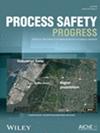Kinetics for the sulfuric acid-catalyzed reactions of ethylene oxide with water and ethylene glycols
IF 1
4区 工程技术
Q4 ENGINEERING, CHEMICAL
引用次数: 0
Abstract
Adiabatic calorimeter experiments have quantified the sulfuric acid-catalyzed reaction of ethylene oxide (EO) with water to form ethylene glycol (EG) and higher glycols. Conditions were selected relevant to industrial safety, such as a scenario of reverse flow of acid from a scrubber to an EO tank. Concentrations of 25–95 wt% EO with acidified water of pH 3.0 down to pH –0.7 were examined. In some experiments, EG was also added to the mix. The best fit apparent reaction rate expression exhibits a 1.5 order in EO concentration, third order in water concentration, nearly first order in acid concentration, and an activation energy of 76,500 kJ/kmol. The reaction model provides an adequate fit of adiabatic self-heat rate versus temperature, pressure rate versus temperature, pressure versus time, and temperature versus time data for a large number of APTAC (Automatic Pressure Tracking Adiabatic Calorimeter) experiments. The model builds on one previously developed for the neutral reactions of EO with water and EGs. A case study involving a sulfuric acid-contaminated EO railcar is presented. The reaction model can help quantify the behavior of EO contaminated with sulfuric acid solution below about 120°C. Above this temperature, other reaction pathways not characterized in this study become more prominent.硫酸催化环氧乙烷与水和乙二醇的反应动力学
绝热量热计实验对硫酸催化环氧乙烷(EO)与水反应生成乙二醇(EG)和高乙二醇的过程进行了量化。实验选择了与工业安全相关的条件,例如酸从洗涤器逆向流向环氧乙烷罐的情景。实验考察了浓度为 25-95 wt% 的环氧乙烷与 pH 值为 3.0 至 pH 值为 -0.7 的酸化水的混合情况。在某些实验中,还在混合液中加入了 EG。最佳拟合表观反应速率表达式显示,环氧乙烷浓度为 1.5 阶,水浓度为三阶,酸浓度接近一阶,活化能为 76,500 kJ/kmol。该反应模型充分拟合了大量 APTAC(自动压力跟踪绝热量热仪)实验的绝热自热速率与温度、压力速率与温度、压力与时间以及温度与时间的关系数据。该模型建立在之前为环氧乙烷与水和 EGs 的中性反应开发的模型基础之上。介绍了一个涉及硫酸污染环氧乙烷轨道车的案例研究。该反应模型有助于量化被硫酸溶液污染的环氧乙烷在 120°C 以下的行为。在这一温度以上,本研究中未描述的其他反应途径变得更加突出。
本文章由计算机程序翻译,如有差异,请以英文原文为准。
求助全文
约1分钟内获得全文
求助全文
来源期刊

Process Safety Progress
工程技术-工程:化工
CiteScore
2.20
自引率
10.00%
发文量
99
审稿时长
6-12 weeks
期刊介绍:
Process Safety Progress covers process safety for engineering professionals. It addresses such topics as incident investigations/case histories, hazardous chemicals management, hazardous leaks prevention, risk assessment, process hazards evaluation, industrial hygiene, fire and explosion analysis, preventive maintenance, vapor cloud dispersion, and regulatory compliance, training, education, and other areas in process safety and loss prevention, including emerging concerns like plant and/or process security. Papers from the annual Loss Prevention Symposium and other AIChE safety conferences are automatically considered for publication, but unsolicited papers, particularly those addressing process safety issues in emerging technologies and industries are encouraged and evaluated equally.
 求助内容:
求助内容: 应助结果提醒方式:
应助结果提醒方式:


